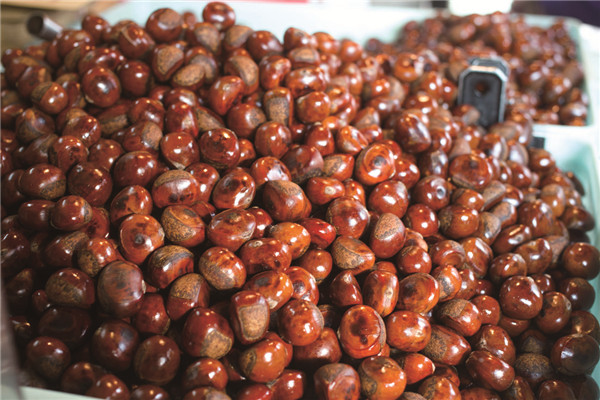 |
|
A glistening shell is revealed after mixing the chestnuts with black sand, sugar and oil. [Photo by Gao Erqiang/China Daily] |
Having started out as a fruit retailer who resorted to selling chestnuts to earn some extra pocket money during winter, Zhang now has three staff and four machines whirling round the clock to process chestnuts. Xiangxiang Chestnut is so popular with locals that an average of three to four tons of chestnuts - priced at 27.6 yuan per kilo ($4.3) - are sold every day.
During a visit to his shop one weekday morning, Zhang noted that business was slow, as compared to times when queues would form as early as seven in the morning. Zhang says that people often buy roasted chestnuts before going to work as the snack helps them to kill time in the office. However, he welcomes the lull in business, saying that it allows his wife to take a break and have a proper breakfast.
A seasonal operation
As chestnuts are a seasonal product, Zhang and his wife only work six months a year. They spend the rest of the time traveling around the country, subletting their shop to other seasonal food businesses, like vendors who sell green bean cakes in summer.
At Xinchangfa, a century-old brand that many senior citizens deem to be the best in the city, business has been stable but not as brisk as Zhang's.
"It's something that people are unlikely to crave every day. Aside from a handful of frequent customers, most of our patrons are passers-by attracted by the aroma of the roasted nuts," says Li Shiliang, general manager of the now state-owned company.
Founded as a subsidiary of a mom-and-pop grocery store in 1935, Xinchangfa sells its chestnuts at a higher price of 49.6 yuan per kilo and Li justifies this by saying that the company uses only the best from Qianxi. However, Li also concedes that the high price of their chestnuts has likely put off some of the younger customers. The amount of roasted chestnuts sold at Xinchangfa's outlets in the city is equal to the what Zhang sells at his one store.
"It's all a matter of taste," says Du Caiqing, the executive chef at Xindalu, a Chinese restaurant along the Bund. "Southern chestnuts are smaller in size and sweeter in taste, while northern ones boast a stickier texture."
Du adds that although Shanghainese don't often cook using chestnuts, seasonal dishes featuring these nuts are always popular at his restaurant. For the winter menu this year, Du is serving an appetizer made of chestnuts, pumpkin and hawthorn jam.
"Winter is the season when creatures in nature go into hibernation, leaving us chefs fewer things to cook. Chestnuts are perhaps the one little sweet treat left for us. It's nature's candy," he says.
|
|
|
|
|
|
|
|
